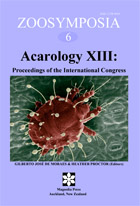Abstract
The Red PalmMite (RPM), Raoiella indica Hirst, has been reported to attack several plant species in theAmericas, mainly palm and banana species. High population levels of this mite have been found damaging coconut and banana in Cuba. The objectives of this work were to estimate the potential of R. indica as a pest in Cuba and to evaluate the effectiveness of Dicofol and Bacillus thuringiensis for its control. The following activities were conducted to meet the first objective: a) evaluation of its host range; b) comparison of its biotic potential on coconut and banana leaves; and c) determination of its population dynamics on banana (Musa acuminata Colla Cavendish subgroup). To meet the second objective, a study was conducted to determine the effect of the chemical acaricideDicofol and line 13 of Bacillus thuringiensis (LBt-13) in the control of RPM. Twenty one plant species were found as host, of which 11 areArecaceae, threeMusaceae, two Heliconiaceae, two Zingiberaceae, one Strelitziaceae and two Cycadaceae.Mycrocycas calocoma (Miq.)A.D.C and Cycas sp. are reported as new hosts for this mite. The immature phase was completed in about the same time on coconut and banana leaves, respectively 31.4 ± 3.3 and 33.4 ± 4.8 days, 26.3 ± 1.3°C, 75 ± 4%relative humidity and 14:10 daily photophase. Female oviposition period, longevity and total oviposition were higher on coconut than on banana. RPM population levels tended to increase inmonthswith lowrainfall and to decrease inmonthswith high rainfall. The predator Amblyseius largoensis (Muma) (Phytoseiidae) was the only predator found associated with RPM. In general, there was a correspondence between prey and predator population trends.Dicofol caused totalmortality of R. indica,whereas nomortalitywas observedwith B. thuringiensis. Dicofol can still be used under particular situations in Cuba, e.g. in nurseries, but itswidespread use is not recommended. Further studies are required to evaluate the actual impact of A. largoensis as a control agent of R. indica, and about its possible practical application by growers, using mass produced specimens.

